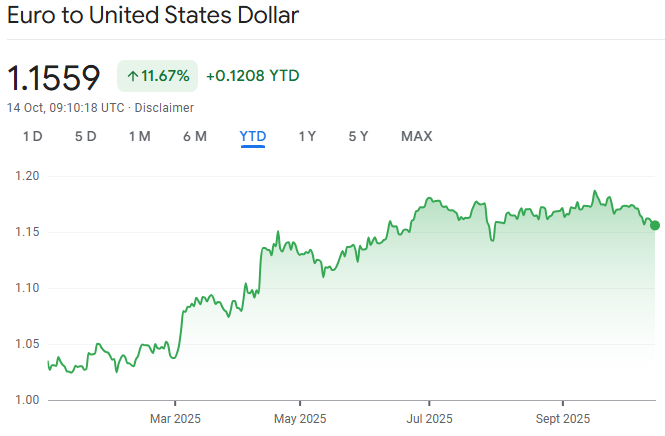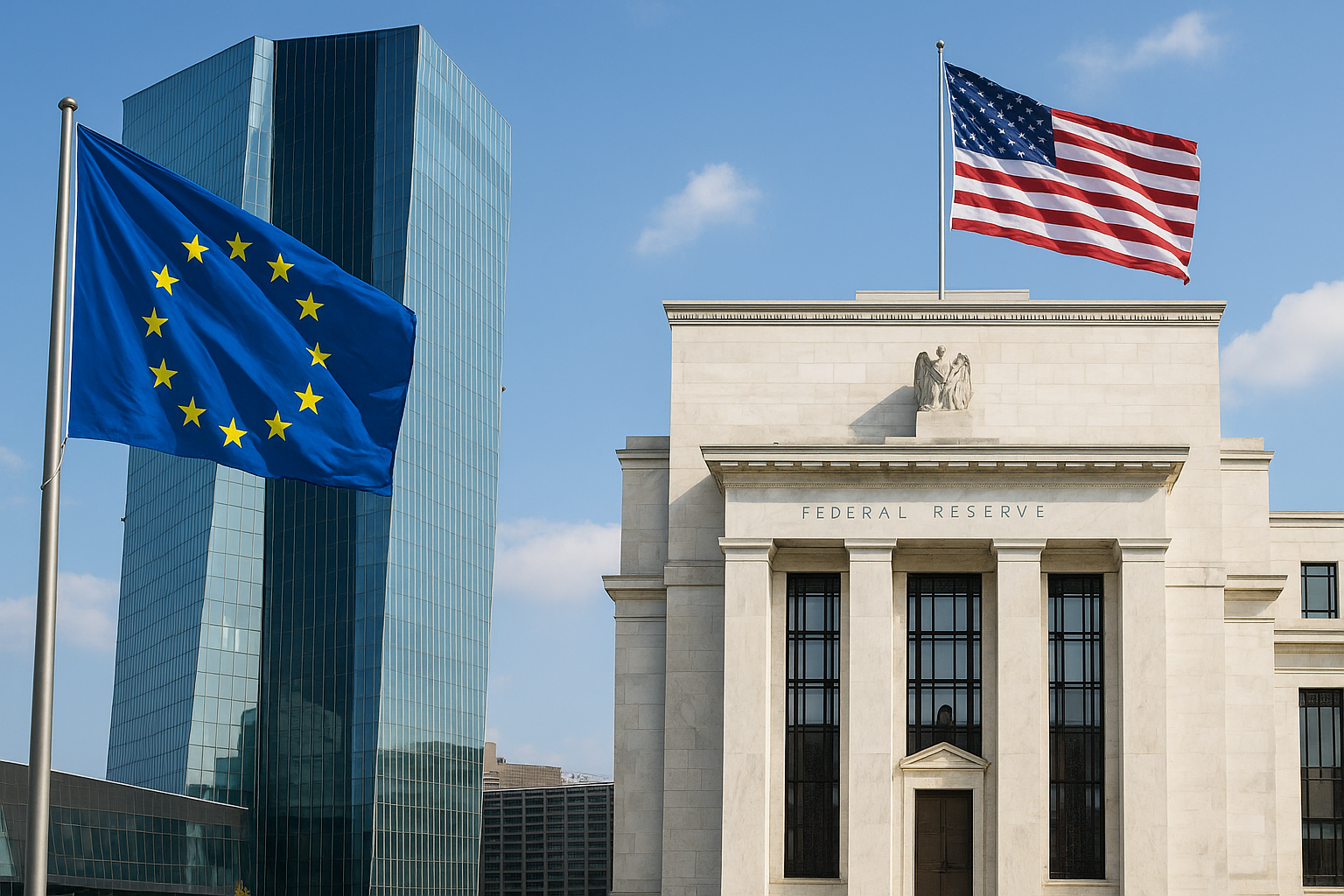Quick 6-Month EUR/USD Forecast (August 2025–January 2026):

Short-term (October–December): The pair has tested support at 1.1550 and held, confirming the lower bound of the projected range. Most forecasts now point to continued trading between 1.15 and 1.17 through year-end. Upside attempts towards 1.1760–1.1800 face resistance, while further weakness to 1.14 remains possible if dollar demand strengthens or French political uncertainty persists.
Current EUR/USD Exchange Rate and Recent Moves
As of October 14, 2025, EUR/USD trades around 1.156, near the lower end of its recent range. The pair has declined over 1.8% in the past month, pressured by renewed dollar strength and political strain in France. Support at 1.1550 has held on multiple tests, but the price remains well below resistance levels near 1.1700–1.1760.
Updated Forecast and Technical Levels
Near-Term (August–September 2025):
-
The technical bias is neutral to slightly bullish, with resistance at 1.1700/1.1760/1.1790 and support at 1.1600/1.1550/1.1500.
-
A bullish breakout above 1.18 could target 1.20–1.23, but this is only likely if ECB/Fed surprises markets or risk sentiment turns sharply positive.
Failure to clear 1.18/1.1790 likely keeps the pair trapped in a broad 1.15–1.17 range, with risk of fresh drops if support at 1.1550 gives way.
Medium-Term (October–January 2026):
Forecasts for early 2026 remain divided. Conservative models from Trading Economics and Standard Chartered project EUR/USD at 1.13-1.17 by Q1 2026, citing slow eurozone growth, French political instability, and limited ECB easing room. These projections assume the Fed maintains a cautious approach and dollar strength persists.
However, most major investment banks forecast higher levels between 1.17 and 1.24 by mid-2026, expecting Fed rate cuts to weaken the dollar and capital rotation towards European assets. JP Morgan targets 1.22 by March 2026, while RBC sees 1.24 by year-end on expectations of improved eurozone growth and reduced hedging costs on US assets.
Key Drivers Influencing EUR/USD

Central Bank Policy:
The ECB held its deposit rate at 2.00% at the September meeting, maintaining the level set in June 2025. September inflation rose to 2.2%, up from 2.0% in August, driven by services and energy prices.
Core inflation remained steady at 2.3%. Policymakers concluded that current rates are robust enough to manage shocks and agreed to wait for more clarity before any further moves. The next decision is due October 30, but no additional cuts are expected in 2025. [1]
The Fed cut rates by 25 basis points in September 2025, bringing the federal funds rate to 4.00–4.25%. The decision followed softer jobs data in August and marks the first reduction since December 2024.
Markets widely expect another 25 basis point cut at the October 29 meeting, with policymakers pencilling in two more cuts by year-end. August inflation held at 2.9%, still above the Fed's 2% target, but slowing job growth and trade disruptions have shifted the focus towards supporting the labour market. [2]
Economic Data:
-
Eurozone Q2 GDP grew just 0.1% QoQ, with weak output from Germany and Italy offset by Spain and Portugal. Annual growth is 1.4%.
US GDP growth has moderated in the first half of the year due to tariffs and weaker consumer spending, but activity remains above 2%. US inflation ticked up to 2.9% in August, continuing to run above the Fed's 2% target despite slowing employment gains.
Geopolitics and Market Sentiment:
-
Fresh US tariffs on European goods in August are hurting the euro. Eurozone faces persistent political uncertainty (Germany, France) and risk of further trade retaliation.
-
Safe-haven flows into USD intensify during risk-off moves and US election uncertainty.
Global appetite for risk (stocks, commodities) continues to determine daily swings.
Technical Analysis for Traders (August 2025)

-
Support: 1.1600, 1.1550, key zone 1.1500. A break below 1.1500 triggers the next leg lower towards 1.1420 or even 1.1300 on strong USD surges.
-
Resistance: 1.1700, 1.1760, major hurdle 1.1790. A clear break opens up the 1.18–1.20 zone.
-
Indicators (RSI, MACD): Slightly bullish, RSI in the low 50s, but not overbought. Momentum appears to be fading near resistance.
Current trends: The pair has tested and held support at 1.1550 multiple times, confirming this as a key floor. Rallies remain capped below 1.1700, with price action reflecting a range-bound environment. Momentum indicators sit in neutral territory, with no clear directional bias.
Trading Strategies
1. Trend Following:
Buy pullbacks to support (1.1600/1.1550), sell rallies to resistance (1.1760/1.1790). Confirm with moving averages, follow market reaction to data, and adjust as trends emerge.
2. Range Trading:
If EUR/USD remains between 1.15 and 1.18, look for short-term buys at lows and sells at highs.
3. Breakout Trading:
Watch for a break above 1.1790/1.18 for further upside, or below 1.1500 for a downside extension.
4. Event-Driven Trading:
React to US CPI, Eurozone PMI, and central bank meetings. Keep risk limited ahead of big news.
FAQs
1. Should I exchange dollars for euros now or wait?
The current rate of 1.1555 sits near established support at 1.1550, offering reasonable value for immediate exchanges. Those who can wait might see rates push towards 1.17, though upside appears limited with resistance at 1.1760 remaining intact.
2. Will the euro strengthen or weaken against the dollar by year-end?
Most forecasts point to continued range-bound trading between 1.15 and 1.17, with a slight bias towards dollar strength given weak eurozone growth and persistent US inflation at 2.9%. A meaningful break above 1.1760 or below 1.1500 would require significant policy shifts or economic surprises.
3. What trading strategy works best for EUR/USD right now?
Range trading suits the current environment: buy near support at 1.1550–1.1600 and sell near resistance at 1.1700–1.1760. Watch for volatility around Fed and ECB meetings on October 29-30, as these events could trigger the next directional move.
Conclusion
The EUR/USD pair is trading at 1.1555 as of October 14, 2025. The pair has declined roughly 1.8% over the past month, pressured by renewed dollar strength and political uncertainty in France. [3]
Forecasts through year-end continue to point towards a range-bound market between 1.15 and 1.17, with support at 1.1550 holding firm on multiple tests. Resistance near 1.1700–1.1760 has capped recent rallies, confirming the choppy character of this market.
Central bank decisions in late October, upcoming inflation data from both regions, and the trajectory of US-China trade negotiations will determine whether the pair breaks out of this range or continues to oscillate within familiar boundaries.
Traders who adapt their strategies around these established technical levels and respond to scheduled risk events stand to find opportunity in what remains a volatile but well-defined trading environment.
Disclaimer: This material is for general information purposes only and is not intended as (and should not be considered to be) financial, investment, or other advice on which reliance should be placed. No opinion given in the material constitutes a recommendation by EBC or the author that any particular investment, security, transaction, or investment strategy is suitable for any specific person.
Sources
[1] https://www.ecb.europa.eu/stats/policy_and_exchange_rates/key_ecb_interest_rates/html/index.en.html
[2] https://am.jpmorgan.com/us/en/asset-management/institutional/insights/portfolio-insights/fixed-income/fixed-income-perspectives/fomc-statement-september-2025/
[3] https://www.reuters.com/business/frances-political-uncertainty-has-toll-affects-confidence-growth-villeroy-says-2025-10-10/
























